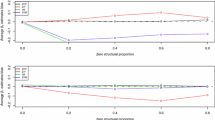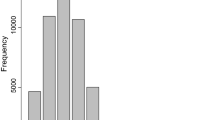Abstract
This paper adds to the recent body of research on fertility by estimating and testing censored poisson regression models and censored negative binomial regression models of household fertility decisions. A novel feature of this study is that in each case the censoring threshold varies from individual to individual. Also, a Lagrange multiplier or score test is used to investigate overdispersion. In these regression models the dependent variable is the number of children. In this situation, censored poisson regression models and censored negative binomial regression models have statistical advantages over OLS, uncensored poisson regression models, and uncensored negative binomial regression models. The censored models employed in this study are estimated using panel data collected from the Consumer Expenditure Survey compiled by the Bureau of Labor Statistics. The findings of this study support the fertility hypothesis of Becker and Lewis (1965-70).
Similar content being viewed by others
References
Barmby T, Cigno A (1990) A sequential probability model of fertility Patterns. Journal of Population Economics 3(1):31–51
Becker GS (1976) The economic approach to human behavior. Chicago IL, The University of Chicago Press
Becker GS (1960) An economic analysis of fertility. Demographic and Economic Change in Developed Countries. Princeton NJ, Princeton University Press and the National Bureau of Economic Research
Becker GS, Lewis HG (1973) On the interaction between the quantity and quality of children. Journal of Political Economy 81(2):279–288
Becker GS (1975) Human capital. Chicago IL, The University of Chicago Press
Berndt ER, Hall BH, Hall RE, Hausman JH (1974) Estimation and inference in non-linear structural models. Annals of Economic and Social Measurement 3(4):653–665
Browning M (1992) Children and household economic behavior. Journal of Economic Literature 30(3):1435–1475
Cameron A, Trivedi P (1990) Regression based tests for over dispersion in the poisson model. Journal of Econometrics 46:347–364
Cremer H, Pestieau P (1991) Bequests, filial attention and fertility. Economica 58(2):359–375
Donaldson L (1991) Fertility patterns of the transition onset: Insights of the living standards model. Journal of Economic Development 16(2):129–144
Easterlin RA (1968) Population, labor force and long swings in economic growth: The American experience. New York NY, National Bureau of Economic Research
Easterlin RA (1975) An economic framework for fertility analysis. Studies in Family Planning 7(1):54–63
Folbre N (1994) Children as public goods. American Economic Review 84(2):86–90
Friedlander D, Schellelans J, Ben-Moshe E (1991) The transition from high to low marital fertility: Cultural or socioeconomic determinants? Economic Development and Cultural Change 39(2):331–351
Georgellis Y, Hall WJ (1992) The fertility effect of dependent tax exemptions: Estimates for the United States. Applied Economics 24(10):1139–1145
Goodwin T, Sauer R (1995) Life cycle productivity in academic research: Evidence from cumultative publication histories of academic economists. Southern Economic Journal 61(3):728–743
Grogger J, Carson R (1991) Models for truncated counts. Journal of Applied Econometrics 6:225–238
Gurmu S, Trivedi P (1992) Overdispersion tests for truncated regression models. Journal of Econometrics 54:347–370
Hanushek EA (1992) The trade-off between child quantity and quality. Journal of Political Economy 100(1):84–117
Hausman J, Hall B, Griliches Z (1984) Economic models for court data with an application to the patents — R&D relationship. Econometrics 52:909–938
Heckman JJ, Walker JR (1990) The relationship between wages and income and the timing and spacing of births: Evidence from Swedish longitudinal data. Econometrica 58(6):1411–1441
Jensen ER (1990) An econometric analysis of the old-age security motive for childbearing. International Economic Review 31(4):953–968
Jones AM (1991) An econometric investigation of low birth weight in the United States. Journal of Health Economics 10(1):81–99
Lantz P, Partin M, Palloni A (1992) Using retrospective surveys for estimating the effects of breast-feeding and childspacing on infant and child mortality. Population Studies 46(1):121–139
Leibowitz A (1990) The response of births to changes in health care costs. Journal of Human Resources 25(4):697–711
Leibowitz A (1974) Home investments in children. Journal of Political Economy 82(1):111–131
Mayer WJ, Chappell WF (1992) Determinants of entry and exit: Application of the compounded poisson distribution to US industries 1972–1977. Southern Economic Journal 58(3):770–78
Michener R, Tighe C (1992) A poisson regression model of highway fatalities. American Economic Review 82(2):452–6
McCloskey DN (1983) The applied theory of price (Second Edition). New York NY, Macmillan Publishing Company
Mocan NH (1990) Business cycles and fertility dynamics in the United States: A vector autoregressive model. Journal of Population Economics 3(2):125–146
Olsen RJ (1994) Fertility and the size of the US labor force. Journal of Economic Literature 32(1):60–100
Ozuna T, Gomez I (1994) Estimating a system of recreation demand functions using a seemingly unrelated poisson regression approach. The Review of Economics and Statistics 76:356–360
Prinz A (1990) Endogenous fertility, altruistic behavior across generations, and social security systems. Journal of Population Economics 3(3):179–192
Sobel ME, Arminger G (1992) Modeling household fertility decisions: A nonlinear simultaneous probit model. Journal of the American Statistical Association 87(4):38–47
Stigler GJ, Becker GS (1977) De gustibus non est disputandum. American Economic Review 67(1):76–90
Terza JV (1985) A tobit-type estimator for the censored poisson regression model. Economics Letters 18(6):361–365
Tsakloglou P (1991) Estimation and comparison of two simple models of equivalence scales for the cost of children. Economic Journal 101(4):343–357
Wolfe BL, Behrman JR (1992) The synthesis of economic fertility models: A latent variable investigation of some critical attributes. Journal of Population Economics 5(1):1–16
Author information
Authors and Affiliations
Rights and permissions
About this article
Cite this article
Caudill, S.B., Mixon, F.G. Modeling household fertility decisions: Estimation and testing of censored regression models for count data. Empirical Economics 20, 183–196 (1995). https://doi.org/10.1007/BF01205434
Received:
Revised:
Issue Date:
DOI: https://doi.org/10.1007/BF01205434




